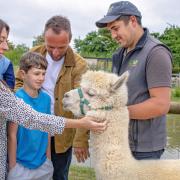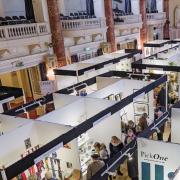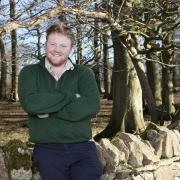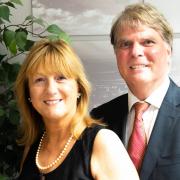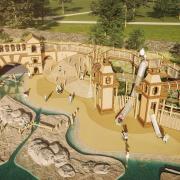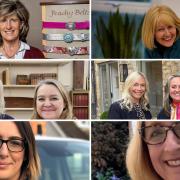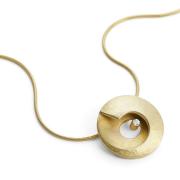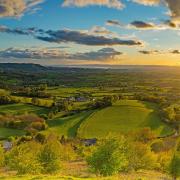Exceptional design and incredible vision are the hallmarks of coombes:everitt architects. John Everitt tells Tanya Gledhill how the practice is building on its success

When John Everitt met Toby Coombes on Cheltenham Borough Council’s Architects’ Panel and hatched a plan for a new architectural practice, neither could have predicted quite how successful their partnership would be.
But eight years on, coombes:everitt architects is one of Gloucestershire’s most in-demand practices with a client base most of its rivals can only dream of.
From stunning country homes to sensitive Regency conversions, quirky subterranean developments to German kit houses, the portfolio is as diverse as it is impressive.
John, who was working for Evans Jones in Cheltenham, and Toby, then at Beswicks in Tewkesbury, had long thought about setting up on their own.
So in 2010 they left their respective posts and set up coombes:everitt architects in a converted dairy unit near Sudeley Castle in Winchcombe.
It was the perfect spot to channel their creativity and the incentive they needed to build a new client base from scratch - a task John says was no mean feat.
“We were very lucky but we worked very hard to go out and get clients,” he adds.
“Quite rightly we weren’t allowed to take clients, and not doing that gave us a real kick to get out and see people and go knocking on doors and say ‘this is who we are, this is what we do’.
“It probably took five or six months to get a bit of momentum going. Once we got a few applications in, it started to build from there.”

Their first job was a project for a friend in Berkhampstead, a small, terraced house extension. And that led to them doing four or five larger projects nearby.
There was a plethora of established practices in the area specialising in traditional buildings and John and Toby quickly saw a gap in the market for much more imaginative, contemporary schemes.
“There weren’t a lot of good, contemporary schemes being delivered in the Cotswolds by architects local to the Cotswolds, so we felt there was an opportunity there,” says John.
“And so the type of client base that we approached lent itself to that. Now, 70% of the work we do has a more contemporary style.”
The juxtaposition of old and new, the relationship between traditional buildings and contemporary structures needs to be handled with sensitivity.
Coombes:everitt prides itself on delivering a happy marriage of the two.
Often, when it works with listed buildings, the team will seek to add on a more contemporary extension. It’s important for the evolution of the building, says John.
A good example of this is the imposing Vittoria House in Vittoria Walk, Cheltenham, which the team is currently converting from offices back to its former glory - one of the town’s original spa houses.
“You want do so something that enables the two to read,” he adds. “You can still appreciate the historic element, but then you can put something really modern on the back.

“And plus people live very differently now.
“Houses like the big Regency properties, for example, sometimes don’t relate brilliantly to their gardens, they don’t let a lot of light in, and people now want big, open-plan kitchen diners, so unless you’re going to start ripping holes in the buildings - which you don’t really want to do - it’s easier to do a clever connection, and then provide that to the garden.
“It’s just a better way of doing it.”
Now, thanks to their impressive back catalogue of work, business comes through word of mouth and planning consultants and developers they have wowed on past projects.
Sometimes, the client knows exactly what they want. Sometimes they don’t.
Sometimes they come with a list of rooms or an idea of what they want their house to be. Sometimes, their wish-list doesn’t translate into the kind of house they actually want to live in, and it’s the team’s job to interpret this.
“We tend to meet with our clients quite a lot and talk to them,” says John.
“We’ll ask them how they want to live in the house as much as ‘how many bedrooms do you want, how many bathrooms do you want?’
“On a Sunday afternoon, where do they sit to relax? What’s their morning routine? How do they engage with the property? Where do they prepare dinner? Where is the light coming from, left or right?

“Because that’s how the space flows around it and how people use it and interact with it. It’s how people will live in it, rather than being an ego trip for us.”
It strikes me it’s quite an inside out approach, but John insists that’s key to the client’s long-term happiness with the build.
Challenging terrain and unusual sites are coombes:everitt’s speciality.
Each project - whether that’s a set of tiny mews houses or a vast country estate - is bespoke to the client, to their site and the opportunities that brings.
To that end, John and his team dreamed up three, stunning subterranean houses on Aylestone Hill in Hereford, ever-mindful of their impact on the landscape and the view.
The position of the site made it possible to build them two storeys high, only one of which can be seen from the hillside.
Then there is a spectacular new build on Leckhampton Hill, in Cheltenham, which includes an elevated glass dining pod designed to take advantage of a breathtaking, 270-degree panoramic vista.
Difficult for the client and planners to envisage, scaffolding was rigged up so they could, for the first time, stand where the client’s dining table would eventually be and look out over the valley.
Immediately, they were sold on the three-year scheme which took “a lot of engineering, a lot of concrete, a lot of steel” in the build.

Another client bought a plot in Winchcombe, and John and his team angled the house so Winchcombe Church was framed in the window as they walked into and through the hallway.
They had got married there, and it was a view very special to them.
It’s imaginative, personal touches like this which has seen the practice grow exponentially.
Now, John and Toby employ 13 people in a light and airy Regency building in Bath Road - a world away from the atmospheric dairy unit with its log burner and low ceilings.
“It suits us, being here,” says John, 43, who with Toby, 46, moved the team from Winchcombe in March this year.
“It’s made us more visible and is allowing us to grow, and it’s fantastic to be in Cheltenham, where the majority of our clients are.
“Our staff like it too. Many of them live in Cheltenham and they can now walk to work, or cycle in.”
The business is continually evolving, and the practice uses the latest technology to help clients visualise their new home right from the start.
“We’ve started using VR goggles on the big houses we’ve done,” says John, who, with Toby, sits on the Gloucestershire Design Panel for Gfirst LEP.

“There’s a house we’re doing in Battledown at the moment which has quite a lot of angles and overlapping plan forms and you look down through spaces, and I think the client was struggling to visualise that.
“They were, ‘we like this, but it’s a big investment and what if it doesn’t look how we imagine at the end?’
“We used the goggles with them, and that really helped them visualise that if they stand in the kitchen and look through there, they can look over the galleried area into the sitting room, and to the left they can see across that space into the garden and over to the pool house and it really helped them understand it.
“And after that, they were like, ‘Yes! Let’s just get on with it.’ It really helps the client see what’s going on in our minds.”
This approach works particularly well with the overseas clients, of which there are many, keeping the momentum going with the drawings, planning process and build, rather than having to stall and wait for face-to-face meetings.
3D printing is another tool which John predicts will become more mainstream and kit houses are being requested by more and more clients.
Right now, in Evesham, the practice is leading a development of 80 kit houses which will be made in a factory before being assembled on-site in a fraction of the time a traditional build would take.
“It’s a really good approach,” John says. “It’s good for local authorities because it’ll get some housing built. The build phase takes three or four days.
“In terms of longevity, they’re timber-framed and a lot of it comes down to workmanship.

“But arguably, being built in a factory which is warm and dry, rather than a bricklayer trying to lay bricks in the rain - in theory the work should be a lot, lot better.”
One project which gives John huge satisfaction is Bradbury Gardens in Pittville, an independent living block for students at National Star - a college in Ullenwood dedicated to young adults with physical disabilities and brain injuries.
The three-year scheme was finished in 2015 and was coombe:everitt’s first big project.
“We came up with something that was quite different, and the college quite liked that,” he remembers.
“It’s a very different thing, working on something like this.
In some ways it’s more challenging, but there’s not a single room there that I wouldn’t be happy to have as my bedroom.
“And I think that ought to be the benchmark. If it works, would I be prepared to sleep here, to live here? Part of its joy is the views right across the lake. Any house in Cheltenham would be pleased to have that view.”
Another of which he is proud is a new-build in Battledown utilising local stone and copper cladding which reflects the light beautifully and anchors the building into its environment - a huge consideration in any of the practice’s designs.
A curved house in Cowley was given planning permission last year - curved because it swoops around an ancient willow tree in the garden which the team built around, rather than felling it.
Even Cheltenham’s Lower High Street is being given the coombes:everitt treatment with 40 flats on the site of the old bingo hall. Upcoming is a development of 26 large houses at Ullenwood, along with some masterplanning for big developers on sites of 200-plus units.
Inspiration for schemes comes from many places, he says.
He loves the “clever” HR Owen Aston Martin dealership in Cheltenham, for example, and even has a soft spot for the much-maligned Eagle Tower. And he loves London, too - the Shard, the Gherkin, the nicknamed Walkie Talkie building in Fenchurch and their impact on the skyline.
Running and swimming are two of John’s passions when he’s not enjoying time at home with wife Sarah and children Jesse and Lily in Andoversford - a house he amusingly describes as having “potential”.
Is it the classic ‘cobblers’ children, worst shod’ thing, I ask? He laughs.
“My excuse is we’re so busy at work, I don’t have time to work on my own house.
“But one day it’d be lovely to build our own house. Maybe when the children have grown up and the business has calmed down a bit. Maybe.”




